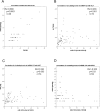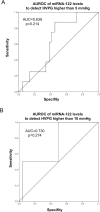Circulating miRNA-122 levels are associated with hepatic necroinflammation and portal hypertension in HIV/HCV coinfection - PubMed
- ️Thu Jan 01 2015
. 2015 Feb 3;10(2):e0116768.
doi: 10.1371/journal.pone.0116768. eCollection 2015.
Thomas Reiberger 2 , Jia Huang 3 , Hannah Eischeid 3 , Robert Schierwagen 1 , Mattias Mandorfer 2 , Evrim Anadol 1 , Philipp Schwabl 2 , Carolynne Schwarze-Zander 1 , Ute Warnecke-Eberz 4 , Christian P Strassburg 1 , Jürgen K Rockstroh 5 , Markus Peck-Radosavljevic 2 , Margarete Odenthal 3 , Jonel Trebicka 1
Affiliations
- PMID: 25646812
- PMCID: PMC4315411
- DOI: 10.1371/journal.pone.0116768
Circulating miRNA-122 levels are associated with hepatic necroinflammation and portal hypertension in HIV/HCV coinfection
Christian Jansen et al. PLoS One. 2015.
Abstract
Background: Introduction of combined antiretroviral therapy (cART) has improved survival of HIV infected individuals, while the relative contribution of liver-related mortality increased. Especially in HIV/HCV-coinfected patients hepatic fibrosis and portal hypertension represent the main causes of liver-related morbidity and mortality. Circulating miRNA-122 levels are elevated in HIV patients and have been shown to correlate with severity of liver injury. However, the association of miRNA-122 levels and hepatic fibrosis and portal hypertension remains to be explored in HIV/HCV coinfection.
Methods: From a total of 74 (31% female) patients with HIV/HCV coinfection were included. Serum levels of miRNA-122 were analyzed by quantitative polymerase chain reaction (PCR) and normalized to SV-40 spike-in RNA. Hepatic venous pressure gradient (HVPG) was measured in 52 (70%) patients and the fibrosis stage was determined in 63 (85%) patients using transient elastography.
Results: The levels of circulating miRNA-122 were increased in HIV/HCV coinfected patients and significantly correlated with the alanine aminotransferase (ALT) (rs = 0.438; p<0.001) and aspartate transaminase AST values (rs = 0.336; p = 0.003), but not with fibrosis stage (p = n.s.). Interestingly, miRNA-122 levels showed an inverse correlation with hepatic venous pressure gradient (HVPG) (rs = -0.302; p = 0.03).
Conclusion: Elevated miRNA-122 levels are associated with liver injury, and with low HVPG. Though, miRNA-122 levels are not suitable to predict the degree of fibrosis, they might function as indicators for portal hypertension in HIV/HCV coinfected patients.
Conflict of interest statement
Competing Interests: The authors have declared that no competing interests exist.
Figures

Circulating miRNA-122 levels were measured in seventy-four patients with HIV/HCV coinfection. Hepatic venous pressure gradient (HVPG) was measured in fifty-two patients. The fibrosis stage was determined using transient elastography in 63 patients.

HVPG correlates (rs = 0.689; p = 1.47*10−7) with transient elastography assessed by FibroScan© (A). The levels of circulating miRNA-122 measured in peripheral blood showed significant correlations with ALT (rs = 0.438; p<0.001) (B) and AST (rs = 0.336; p = 0.003) (C). The levels of circulating miRNA-122 measured in peripheral blood showed significant (rs = 0.−302; p = 0.03) inverse correlation with HVPG (D). Data were presented using Spearman coefficient rs and p-values. The levels of miRNA-122 were normalized to SV40 and shown as the x-fold of SV40.

AUROC analysis demonstrated that we unfortunatelydid not succeeded to define a cut-off value to predict portal hypertension. (A) AUC of 0.639 (p = 0.214) for detecting an HVPG of 5mmHG. (B) AUC of 0.73 (p = 0.274) for detecting an HVPG of 10mmHg—indicating clinically significant portal hypertension.
Similar articles
-
Jansen C, Leeming DJ, Mandorfer M, Byrjalsen I, Schierwagen R, Schwabl P, Karsdal MA, Anadol E, Strassburg CP, Rockstroh J, Peck-Radosavljevic M, Møller S, Bendtsen F, Krag A, Reiberger T, Trebicka J. Jansen C, et al. PLoS One. 2014 Sep 29;9(9):e108544. doi: 10.1371/journal.pone.0108544. eCollection 2014. PLoS One. 2014. PMID: 25265505 Free PMC article.
-
Schwabl P, Mandorfer M, Steiner S, Scheiner B, Chromy D, Herac M, Bucsics T, Hayden H, Grabmeier-Pfistershammer K, Ferlitsch A, Oberhuber G, Trauner M, Peck-Radosavljevic M, Reiberger T. Schwabl P, et al. Aliment Pharmacol Ther. 2017 Jan;45(1):139-149. doi: 10.1111/apt.13844. Epub 2016 Nov 7. Aliment Pharmacol Ther. 2017. PMID: 27910154
-
Scheiner B, Mandorfer M, Schwabl P, Payer BA, Bucsics T, Bota S, Aichelburg MC, Grabmeier-Pfistershammer K, Stättermayer A, Ferenci P, Trauner M, Peck-Radosavljevic M, Reiberger T. Scheiner B, et al. PLoS One. 2015 Nov 23;10(11):e0143429. doi: 10.1371/journal.pone.0143429. eCollection 2015. PLoS One. 2015. PMID: 26599080 Free PMC article.
-
Pérez-Latorre L, Sánchez-Conde M, Rincón D, Miralles P, Aldámiz-Echevarría T, Carrero A, Tejerina F, Díez C, Bellón JM, Bañares R, Berenguer J. Pérez-Latorre L, et al. Clin Infect Dis. 2014 Mar;58(5):713-8. doi: 10.1093/cid/cit768. Epub 2013 Nov 21. Clin Infect Dis. 2014. PMID: 24265358
-
Molecular mechanisms of liver fibrosis in HIV/HCV coinfection.
Mastroianni CM, Lichtner M, Mascia C, Zuccalà P, Vullo V. Mastroianni CM, et al. Int J Mol Sci. 2014 May 26;15(6):9184-208. doi: 10.3390/ijms15069184. Int J Mol Sci. 2014. PMID: 24865485 Free PMC article. Review.
Cited by
-
Dkhil MA, Al-Quraishy SA, Abdel-Baki AS, Delic D, Wunderlich F. Dkhil MA, et al. Front Microbiol. 2017 Jan 11;7:2155. doi: 10.3389/fmicb.2016.02155. eCollection 2016. Front Microbiol. 2017. PMID: 28123381 Free PMC article.
-
Miyaaki H, Takatsuki M, Ichikawa T, Hidaka M, Soyama A, Ohdan H, Inomata Y, Uemoto S, Kokudo N, Nakao K, Eguchi S. Miyaaki H, et al. Ann Transplant. 2017 Nov 24;22:701-706. doi: 10.12659/aot.906236. Ann Transplant. 2017. PMID: 29170365 Free PMC article.
-
Hepatic Stellate Cells and microRNAs in Pathogenesis of Liver Fibrosis.
Kitano M, Bloomston PM. Kitano M, et al. J Clin Med. 2016 Mar 16;5(3):38. doi: 10.3390/jcm5030038. J Clin Med. 2016. PMID: 26999230 Free PMC article. Review.
-
Singhal A, Agrawal A, Ling J. Singhal A, et al. J Cell Mol Med. 2018 Apr;22(4):2071-2085. doi: 10.1111/jcmm.13553. Epub 2018 Feb 7. J Cell Mol Med. 2018. PMID: 29411512 Free PMC article. Review.
-
Brites D, Fernandes A. Brites D, et al. Front Cell Neurosci. 2015 Dec 17;9:476. doi: 10.3389/fncel.2015.00476. eCollection 2015. Front Cell Neurosci. 2015. PMID: 26733805 Free PMC article. Review.
References
-
- UNAIDS (2013) in Global Report 2013.
Publication types
MeSH terms
Substances
Grants and funding
This work was supported by the Deutsche Forschungsgemeinschaft (SFB TRR57 P18 to J.T.), J. & W. Hector-Foundation (M60.2 to J.T.), unrestricted research grants from Roche Austria (to M.P.R.), MSD Austria (to M.P.R.), DZIF TTU HIV Project 05.803, and the German Center for Infection Research (DZIF), Research and Education program of the Medical Faculty of the University of Cologne, German Competence Network for Viral Hepatitis (Hepnet), German Ministry of Education and Research (BMBF), Grant No 01KI0601 (to M.O.), and German Liver Foundation (to M.O.). The funders had no role in study design, data collection and analysis, decision to publish, or preparation of the manuscript.
LinkOut - more resources
Full Text Sources
Other Literature Sources
Medical